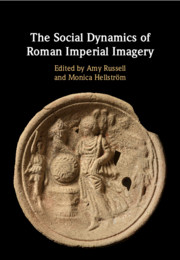Book contents
- The Social Dynamics of Roman Imperial Imagery
- The Social Dynamics of Roman Imperial Imagery
- Copyright page
- Contents
- Figures
- Contributors
- Acknowledgements
- Abbreviations
- 1 Introduction
- 2 The Altars of the Lares Augusti
- 3 Modelling the Emperor
- 4 Publica numina
- 5 Roman Emperors, Conquest, and Violence
- 6 Court Politics and Imperial Imagery in the Roman Principate
- 7 Local Aspirations and Statues of Emperors in Roman North Africa
- 8 The Altar of P. Perelius Hedulus in Carthage and the Social Aspects of Provincial Image-Making
- 9 Imagines et tituli
- 10 The Imperial Image in Media of Mechanical Reproduction
- 11 When Was an Imperial Image?
- Index
- References
2 - The Altars of the Lares Augusti
A View from the Streets of Augustan Iconography
Published online by Cambridge University Press: 09 November 2020
- The Social Dynamics of Roman Imperial Imagery
- The Social Dynamics of Roman Imperial Imagery
- Copyright page
- Contents
- Figures
- Contributors
- Acknowledgements
- Abbreviations
- 1 Introduction
- 2 The Altars of the Lares Augusti
- 3 Modelling the Emperor
- 4 Publica numina
- 5 Roman Emperors, Conquest, and Violence
- 6 Court Politics and Imperial Imagery in the Roman Principate
- 7 Local Aspirations and Statues of Emperors in Roman North Africa
- 8 The Altar of P. Perelius Hedulus in Carthage and the Social Aspects of Provincial Image-Making
- 9 Imagines et tituli
- 10 The Imperial Image in Media of Mechanical Reproduction
- 11 When Was an Imperial Image?
- Index
- References
Summary
A small group of altars to the Lares Augusti, set up by the vicomagistri of Rome’s urban neighbourhoods in the Augustan period, provides examples of imperial imagery produced by patrons of low social status. Their decoration shows the early effects of new Augustan motifs, but they are not merely examples of imagery trickling down from an original, central prototype. The patrons of these altars adapted and even invented images to express their relationship with the princeps for a local audience, and for viewers the altars were themselves sources of imagery, no less ‘official’ than any other source.
Keywords
- Type
- Chapter
- Information
- The Social Dynamics of Roman Imperial Imagery , pp. 25 - 51Publisher: Cambridge University PressPrint publication year: 2020
References
- 1
- Cited by

